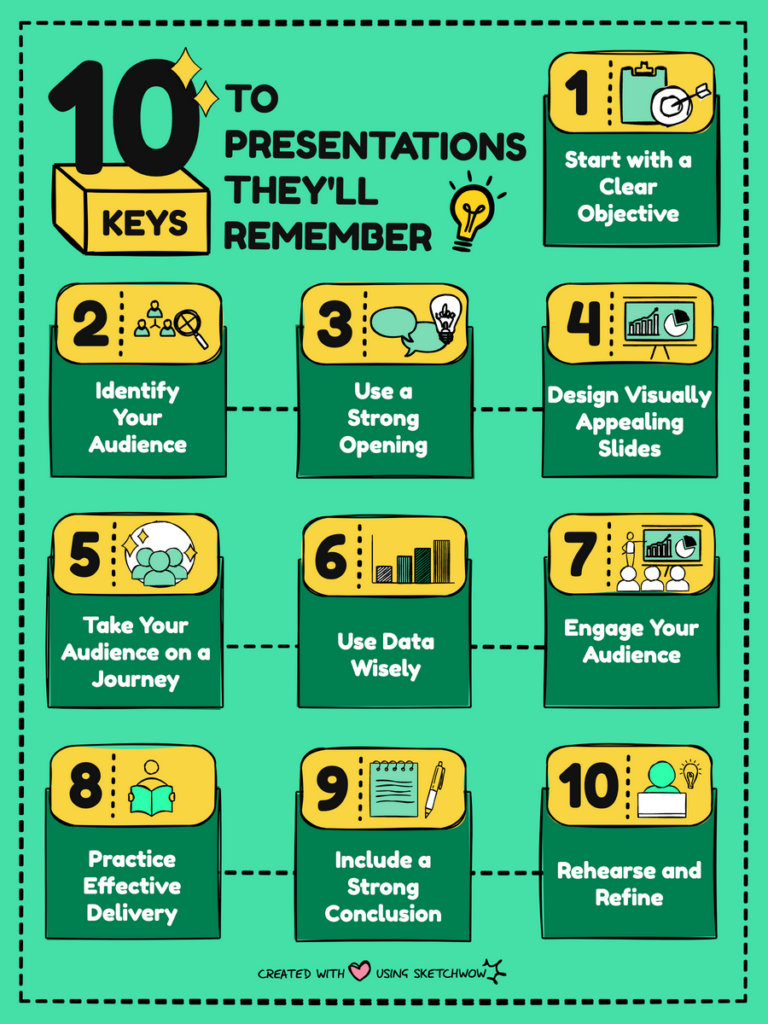Worried about (literally) boring your audience to death? We hear you! Here are some handy pointers to help you do your best in front of an audience.
Creating an engaging presentation is important if you want to captivate your audience, deliver your core message effectively, and leave a lasting impression. Whether you’re presenting in a business meeting, to a conference, or in a classroom, the following tips will help you craft a compelling presentation that firmly holds your audience’s attention from start to finish.
Start with a Clear Objective
Before you begin designing your presentation, define a crystal clear purpose.
What do you want your audience to take away?
What is the CTA of this presentation?
Who are you creating this presentation for?
Having a clear objective will guide your creation process and ensure that your message is delivered with focus and is impactful.
Identify Your Audience
Tailor your presentation to the interests and demographics of your audience. Consider their age, background, understanding of the subject, and what they expect to gain from your presentation. This will help you choose the right language to use, relevant examples, and the level of detail necessary to curate an effective presentation.
Use a Strong Opening
First impressions matter. Start with a hook that grabs attention—an interesting fact, a compelling story, or a thought provoking question. This sets the tone for the rest of your presentation and piques your audience’s curiosity from the beginning.
Design Visually Appealing Slides
Your slides should enhance your message, not overshadow it. However, a visually appealing presentation will slow down the rate of your audience losing interest or becoming distracted. Try using the following design principles to create more visually aesthetic slides:
- Minimal Text: Use bullet points and keywords rather than paragraphs of text.
- High-Quality Images: Include clear and crisp relevant images, charts, and graphics to illustrate your points.
- Consistent Design: Stick to a consistent color scheme, font, and layout throughout your presentation.
Take Your Audience on a Journey
Structuring your presentation as a story can make it more engaging and memorable. A good story has a clear beginning, middle, and end. Introduce a problem, discuss the solution, and conclude with the outcome or call to action. This narrative approach keeps your audience invested in your content.
Use Data Wisely
Data can be powerful, but too much can overwhelm your audience. Present data in a clear and concise manner, using charts and graphs to make it easily digestible. Highlight key points and explain why the data is important.
Engage Your Audience
Interaction keeps your audience engaged. Encourage participation through:
- Questions: Ask questions to provoke thought and discussion.
- Polls and Quizzes: Use interactive tools to gather instant feedback.
- Activities: Incorporate short activities or group discussions to keep energy levels high.
Practice Effective Delivery
How you deliver your presentation is just as important as the content itself. Practice speaking clearly and confidently. Maintain eye contact with your audience and use body language to reinforce your message. Try to vary your tone and pace to keep the presentation dynamic and avoid sounding too robotic.
Include a Strong Conclusion
End your presentation with a strong conclusion that reinforces your key points and calls your audience to action. Summarize the main takeaways and leave your audience with a memorable closing statement or question.
Rehearse and Refine
Practice your presentation multiple times. Rehearsing helps you become familiar with the flow of your content and its delivery and identify any areas that need refining. Consider recording yourself or practicing in front of a colleague to catch mistakes early and get feedback so you can make improvements.

Conclusion
Creating an engaging presentation involves careful planning, a thoughtful design, and effective delivery, all wrapped up in a bow. By starting with a clear objective, knowing your audience, crafting a strong opening, designing visually striking slides, practicing effective delivery, including a strong conclusion, and rehearsing, you can create presentations that captivate and inspire. Implement these tips in your next presentation to make a lasting impact on your audience.


